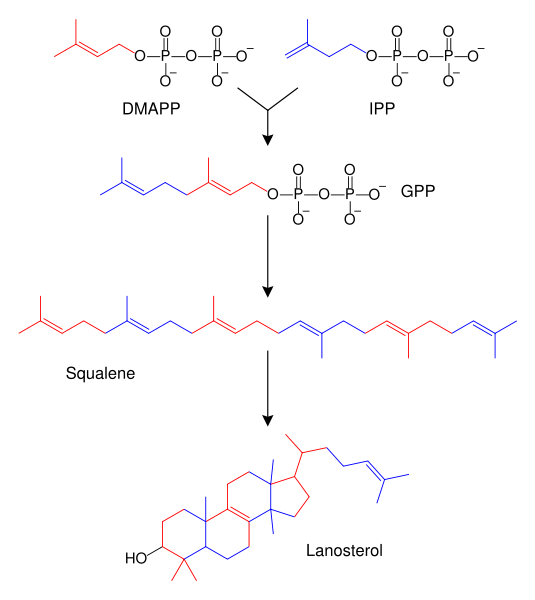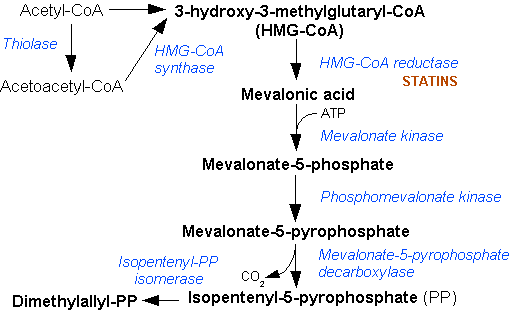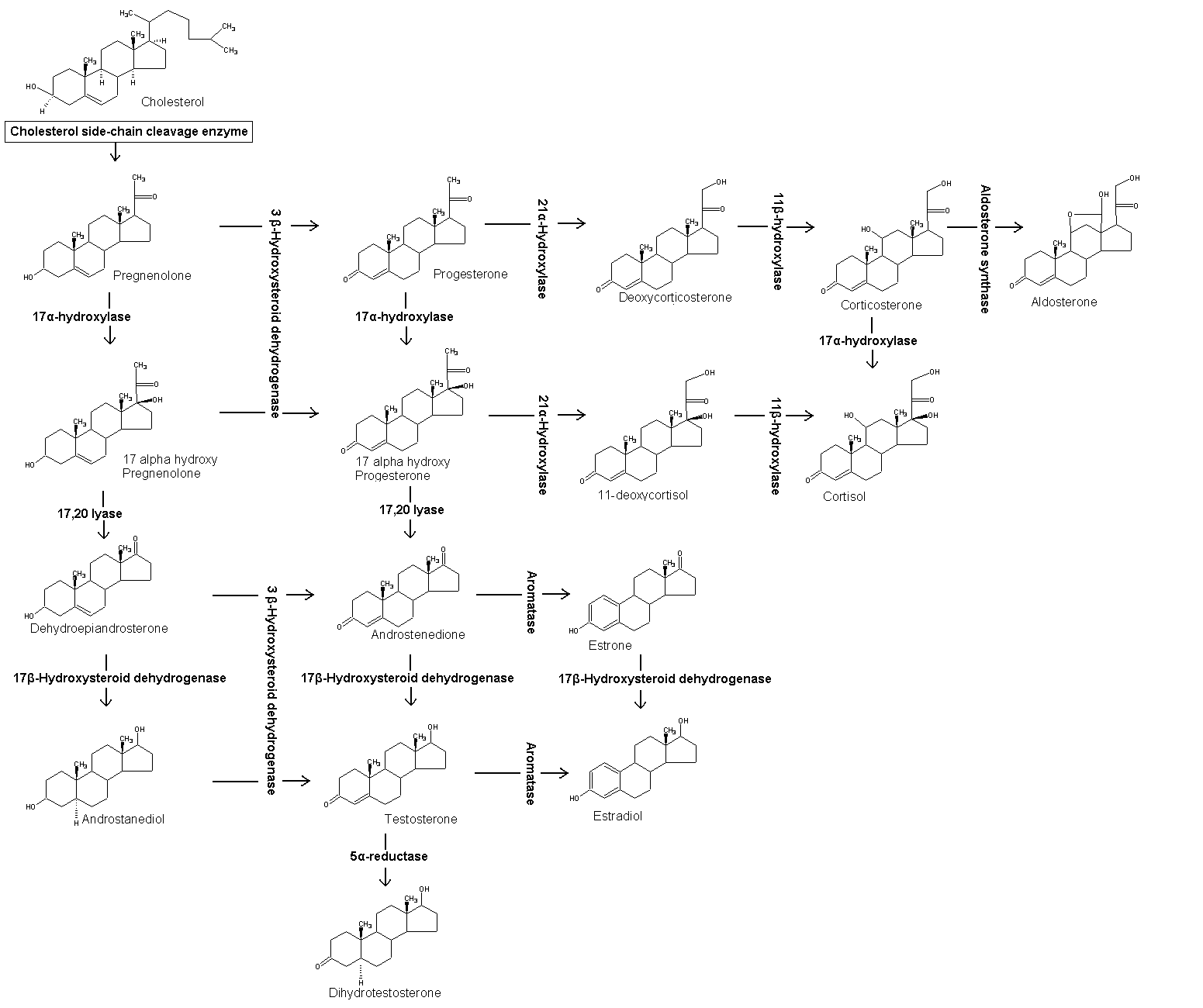Steroid metabolism
 From Wikidoc - Reading time: 4 min
From Wikidoc - Reading time: 4 min

Steroid metabolism is the complete set of chemical reactions in organisms that produce, modify and consume steroids. These metabolic pathways include: steroid synthesis - where steroids are synthesized from more simple precursors, steroidogenesis - where different types of steroids are interconverted, as well as steroid degradation.
Steroid biosynthesis[edit | edit source]
Steroid biosynthesis is an anabolic metabolic pathway that produces steroids from simple precursors. This pathway is carried out in different ways in animals than in many other organisms, making the pathway a common target for antibiotics and other anti-infective drugs. In addition, steroid metabolism in humans is the target of cholesterol-lowering drugs such as statins.
It starts in the mevalonate pathway in humans, with Acetyl-CoA as building blocks, which form DMAPP and IPP[1]. In following steps, DMAPP and IPP form lanosterol, the first steroid. Further modification belongs to the succeeding steroidogenesis.
Mevalonate pathway[edit | edit source]

The mevalonate pathway or HMG-CoA reductase pathway starts with and ends with dimethylallyl pyrophosphate (DMAPP) and isopentenyl pyrophosphate (IPP).
Regulation and feedback[edit | edit source]
Several key enzymes can be activated through DNA transcriptional regulation on activation of SREBP (Sterol Regulatory Element-Binding Protein-1 and -2). This intracellular sensor detects low cholesterol levels and stimulates endogenous production by the HMG-CoA reductase pathway, as well as increasing lipoprotein uptake by up-regulating the LDL receptor. Regulation of this pathway is also achieved by controlling the rate of translation of the mRNA, degradation of reductase and phosphorylation.
Pharmacology[edit | edit source]
A number of drugs target the mevalonate pathway:
- Statins (used for elevated cholesterol levels);
- Bisphosphonates (used in treatment of various bone-degenerative diseases)
In plants and bacteria[edit | edit source]
In plants and bacteria the non-mevalonate pathway uses pyruvate and glyceraldehyde 3-phosphate as substrates.[2][3]
DMAPP to lanosterol[edit | edit source]
Isopentenyl pyrophosphate and dimethylallyl pyrophosphate donate isoprene units, which are assemblied and modificated to form terpenes and isoprenoids[3], which are a large class of lipids that include the carotenoids and form the largest class of plant natural products.[4]
Here, the isoprene units are joined together to make squalene and then folded up and formed into a set of rings to make lanosterol.[5] Lanosterol can then be converted into other steroids such as cholesterol and ergosterol.[6][5]

Steroidogenesis[edit | edit source]
Steroidogenesis is where desired forms of steroids are generated by transformation of other steroids. The pathways of steroidogenesis can differ from organism to organism, but the pathways of human steroidogenesis are shown in the figure.
Products of steroidogenesis include:
Elimination[edit | edit source]
Steroids are mainly oxidized by cytochrome P450 oxidase enzymes, such as CYP3A4, these reactions introduce oxygen into the steroid ring and allows the structure to be broken up by other enzymes, to form bile acids as final products.[7] These bile acids can then be eliminated through secretion from the liver in the bile.[8] The expression of this oxidase gene can be upregulated by the steroid sensor PXR when there is a high blood concentration of steroids.[9]
References[edit | edit source]
- ↑ Grochowski L, Xu H, White R (2006). "Methanocaldococcus jannaschii uses a modified mevalonate pathway for biosynthesis of isopentenyl diphosphate". J Bacteriol. 188 (9): 3192–8. PMID 16621811.
- ↑ Lichtenthaler H (1999). "The 1-Dideoxy-D-xylulose-5-phosphate pathway of isoprenoid biosynthesis in plants". Annu Rev Plant Physiol Plant Mol Biol. 50: 47–65. PMID 15012203.
- ↑ 3.0 3.1 Kuzuyama T, Seto H (2003). "Diversity of the biosynthesis of the isoprene units". Nat Prod Rep. 20 (2): 171–83. PMID 12735695.
- ↑ Dubey V, Bhalla R, Luthra R (2003). "An overview of the non-mevalonate pathway for terpenoid biosynthesis in plants" (PDF). J Biosci. 28 (5): 637–46. PMID 14517367.
- ↑ 5.0 5.1 Schroepfer G (1981). "Sterol biosynthesis". Annu Rev Biochem. 50: 585–621. PMID 7023367.
- ↑ Lees N, Skaggs B, Kirsch D, Bard M (1995). "Cloning of the late genes in the ergosterol biosynthetic pathway of Saccharomyces cerevisiae—a review". Lipids. 30 (3): 221–6. PMID 7791529.
- ↑ Pikuleva IA (2006). "Cytochrome P450s and cholesterol homeostasis". Pharmacol. Ther. 112 (3): 761–73. PMID 16872679.
- ↑ Zollner G, Marschall HU, Wagner M, Trauner M (2006). "Role of nuclear receptors in the adaptive response to bile acids and cholestasis: pathogenetic and therapeutic considerations". Mol. Pharm. 3 (3): 231–51. PMID 16749856.
- ↑ Kliewer S, Goodwin B, Willson T (2002). "The nuclear pregnane X receptor: a key regulator of xenobiotic metabolism". Endocr. Rev. 23 (5): 687–702. PMID 12372848.
 KSF
KSF